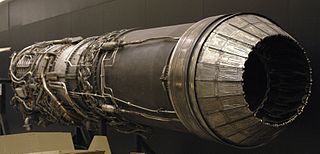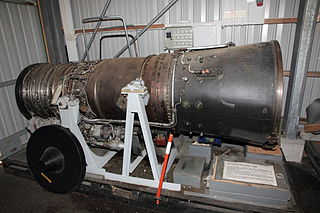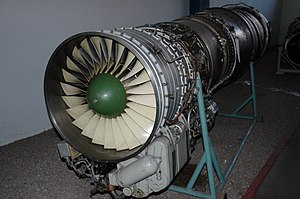
The Pratt & Whitney J57 is an axial-flow turbojet engine developed by Pratt & Whitney in the early 1950s. The J57 was the first 10,000 lbf (45 kN) thrust class engine in the United States. It is a two spool engine.

The Lyulka AL-21 is an axial flow turbojet engine created by the Soviet Design Bureau named for its chief designer Arkhip Lyulka.

The General Electric J79 is an axial-flow turbojet engine built for use in a variety of fighter and bomber aircraft and a supersonic cruise missile. The J79 was produced by General Electric Aircraft Engines in the United States, and under license by several other companies worldwide. Among its major uses was the Lockheed F-104 Starfighter, Convair B-58 Hustler, McDonnell Douglas F-4 Phantom II, North American A-5 Vigilante and IAI Kfir.

The Pratt & Whitney J75 is an axial-flow turbojet engine first flown in 1955. A two-spool design in the 17,000 lbf (76 kN) thrust class, the J75 was essentially the bigger brother of the Pratt & Whitney J57 (JT3C). It was known in civilian service as the JT4A, and in a variety of stationary roles as the GG4 and FT4.

The General Electric/Allison J35 was the United States Air Force's first axial-flow compressor jet engine. Originally developed by General Electric in parallel with the Whittle-based centrifugal-flow J33, the J35 was a fairly simple turbojet, consisting of an eleven-stage axial-flow compressor and a single-stage turbine. With the afterburner, which most models carried, it produced a thrust of 7,400 lbf (33 kN).

The Pratt & Whitney J52 is an axial-flow dual-spool turbojet engine originally designed for the United States Navy, in the 40 kN class. It powered the A-6 Intruder and the AGM-28 Hound Dog cruise missile. As of 2021 the engine was still in use in models of the A-4 Skyhawk.

The Snecma Atar is a French axial-flow turbojet engine built by Snecma. It was derived from the German World War II BMW 018 design, and developed by ex-BMW engineers through a progression of more powerful models. The name is derived from its original design group, Atelier technique aéronautique de Rickenbach near Lindau within the French Occupation Zone of Germany. The Atar powered many of the French post-war jet aircraft, including the Vautour, Étendard and Super Étendard, Super Mystère and several models of the Mirage.

The General Electric J85 is a small single-shaft turbojet engine. Military versions produce up to 3,500 lbf (16 kN) of thrust dry; afterburning variants can reach up to 5,000 lbf (22 kN). The engine, depending upon additional equipment and specific model, weighs from 300 to 500 pounds. It is one of GE's most successful and longest in service military jet engines, with the civilian versions having logged over 16.5 million hours of operation. The United States Air Force plans to continue using the J85 in aircraft through 2040. Civilian models, known as the CJ610, are similar but supplied without an afterburner and are identical to non-afterburning J85 variants, while the CF700 adds a rear-mounted fan for improved fuel economy.

The Tumansky R-13 is a Soviet turbojet engine designed by Sergei Alekseevich Gavrilov.

The Tumansky R-25 is a turbojet engine, which is seen as the ultimate development of Tumansky R-11. It was designed under the leadership of Sergei Alekseevich Gavrilov.

The Lyulka AL-7 was a turbojet designed by Arkhip Mikhailovich Lyulka and produced by his Lyulka design bureau. The engine was produced between 1954 and 1970.

The Tumansky RD-9 was an early Soviet turbojet engine, not based on pre-existing German or British designs. The AM-5, developed by scaling down the AM-3, was available in 1952 and completed testing in 1953; it produced 25.5 kN (5,700 lbf) thrust without afterburner. The AM-5 engine is notable for making possible the first mass-produced supersonic interceptors such as the MiG-19, and the first Soviet all-weather area interceptor, the Yak-25. When Sergei Tumansky replaced Alexander Mikulin as the OKB-24's chief designer in 1956, the engine was renamed RD-9. The engine was later built under license in China as the WP-6.

The Tumansky R-15 is an axial-flow, single-shaft turbojet with an afterburner. Its best known use is on the Mikoyan-Gurevich MiG-25.

The Westinghouse J40 was an early high-performance afterburning turbojet engine designed by Westinghouse Aviation Gas Turbine Division starting in 1946 to a US Navy Bureau of Aeronautics (BuAer) request. BuAer intended to use the design in several fighter aircraft and a bomber. However, while an early low-power design was successful, attempts to scale it up to its full design power failed, and the design was finally abandoned, deemed a "fiasco" and a "flop".

The Allison J71 was a single spool turbojet engine, designed and built in the United States. It began development in 1948 as a much modified J35, originally designated J35-A-23.

The Kuznetsov NK-32 is an afterburning three-spool low bypass turbofan jet engine which powers the Tupolev Tu-160 supersonic bomber, and was fitted to the later model Tupolev Tu-144LL supersonic transport. It produces 245 kN (55,000 lbf) of thrust in afterburner.

The General Electric J73 turbojet was developed by General Electric from the earlier J47 engine. Its original USAF designation was J47-21, but with innovative features including variable inlet guide vanes, double-shell combustor case, and 50% greater airflow was redesignated J73. Its only operational use was in the North American F-86H.

The Yakovlev Yak-140 was a Soviet prototype lightweight supersonic fighter developed during the 1950s. The prototype was completed in 1954, but it was denied authorization to enter flight testing and the program was cancelled in 1956.

The Tumansky R-29 is a Soviet turbojet aircraft engine that was developed in the early 1970s. It is generally described as being in the "third generation" of Soviet gas turbine engines which are characterized by high thrust-to-weight ratios and the use of turbine air cooling.
The Tumansky R-21 was a Soviet turbojet engine of the 1960s. Used for development only, the project was canceled.



















